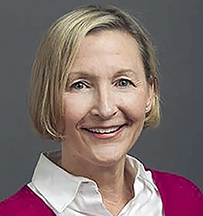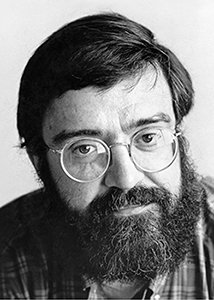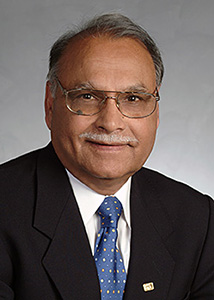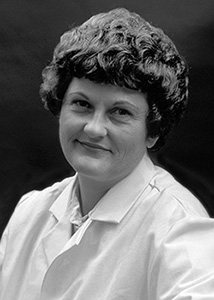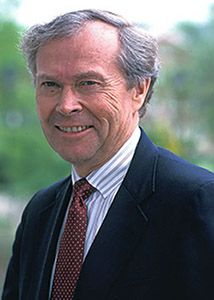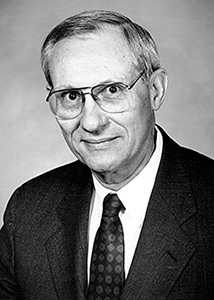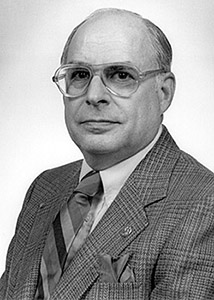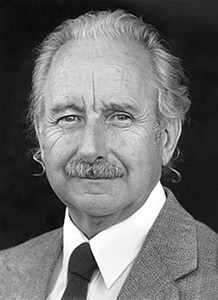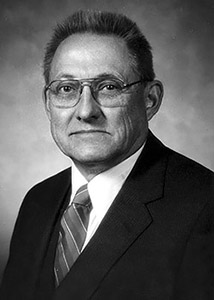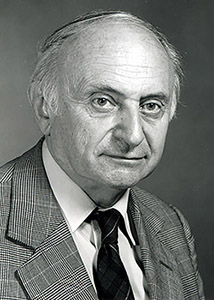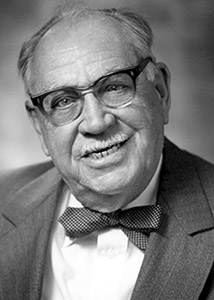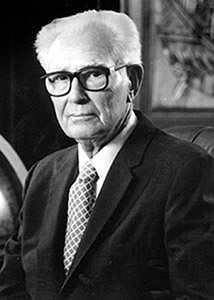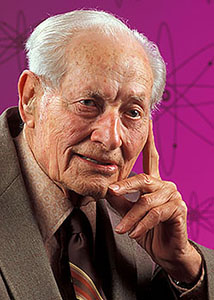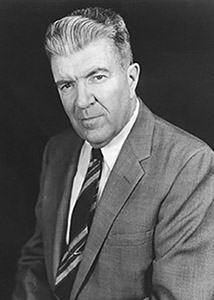ARS National Academy of Sciences Members
One of the highest honors in the science community, NAS election recognizes significant achievements in original research.
This list is arranged in chronological order by year of induction beginning with the current year and ending in 1908.
|
|
Barbara Baker - Elected 2021Barbara Baker, a plant molecular geneticist with the ARS Plant Gene Expression Center in Albany, California, is known for her work with disease resistance genes (R-genes) in plants. Baker’s research revealed that R-genes and the proteins they encode for form a major plant defense system against a broad spectrum of plant pathogens including bacteria, viruses and fungi. The concept of single traits conferring disease resistance to specific pathogens has been around for decades. But Baker was the first to isolate one of these single genes responsible for resistance to a specific plant virus. This gene, named N for Necrosis, codes for a protein that provides resistance to the tobacco mosaic virus. With the advances that have followed Baker’s work, plant scientists and breeders have been able to speed up the process and introduce new disease resistance genes into crops. |
|
|
Elizabeth Ainsworth - Elected 2020Elizabeth Ainsworth, molecular biologist with the Global Change and Photosynthesis Research Unit in Urbana, Illinois, is a lead investigator of SoyFACE Global Change Research (Soybean Free Air Concentration Enrichment) Facility that focuses on providing solutions to the question of how to feed the world in the face of global climate change. Ainsworth’s scientific focus is to identify and utilize genetic variation within crop species to better adapt them for future environmental conditions. Her research efforts include measuring crop responses to global climate changes from the molecular to the agronomic scale and determining the genetic underpinnings of those varieties that are more tolerant of higher concentrations of atmospheric ozone and more responsive to higher carbon dioxide. In 2019, Ainsworth received the National Academy of Science’s Prize in Food and Agriculture Sciences recognizing her for groundbreaking research to show how crops such as corn and soybeans are affected by increases in atmospheric carbon dioxide and ozone in combination with drought and other environmental stresses, along with potential solutions. |
|
|
Ed Buckler - Elected 2014Edward Buckler, geneticist with the ARS Plant, Soil and Nutrition Research Unit in Ithaca, New York, began his large-scale genomics work by developing an encyclopedic amount of information relating the 40,000 genes and nearly 2.3 million base pairs in the maize genome to specific traits in the field. He then developed freely available software and other techniques for analyzing natural genomic diversity. His software has been downloaded more than 20,000 times a year and has been applied to more than 1,500 species. Buckler and his collaborators have developed non-genetically engineered maize varieties with 15 times the typical level of vitamin A—providing a solution to a common sight-threatening deficiency in the developing world. In 2017 Buckler was the first person to receive the National Academy of Science's Prize in Food and Agriculture Sciences recognizing him for pioneering the use of large-scale genomic approaches linking genes with the crop's physical traits. This work is giving plant breeders' better access to key genes and reducing the time needed to improve critical traits that enhance food security. |
|
|
Athanasios Theologis - Elected 2011Athanasios (Sakis) Theologis, molecular biologist with at the Plant Gene Expression Center in Albany, Calif. made major discoveries in the molecular mechanisms of hormone action. Theologis cloned the gene for ACC synthase which catalyzes the first step in ethylene biosynthesis. He also showed that the hormone auxin—naturally occurring plant growth regulator—rapidly stimulates transcription of certain genes and auxin activity can stimulate ethylene production in other plant tissues. Theologis worked with scientists at Stanford University and at the University of Pennsylvania to determine the sequence of the genes of one of the five chromosomes in Arabidopsis thaliana. The Arabidopsis sequencing work is considered to be the first complete, publicly available catalog of the structure of all of the genes that come into play during the life of a flowering plant—from seed to flower to fruit. |
|
|
Robert E. Davis - Elected 2005Robert E. Davis, plant pathologist and researcher leader of the Molecular Plant Pathology Laboratory in Beltsville, Maryland, revolutionized the worlds of plant pathology, medicine, and animal husbandry with his 1979 discovery of spiroplasmas. The fundamental understanding of this entire group of lifeforms rests on his work. A form of bacteria without cell walls, spiroplasmas cause diseases of crop plants and of insects and are suspected in some human maladies. In showing the scientific world that this lifeform exists, Davis opened new categories of research. He showed the scientific community how to culture these microbes and how they survive outside plants on flower petals. Davis developed techniques to detect and identify spiroplasmas and discovered spiroplasma diseases of honey bees and other pollinating insects. He led the project to sequence the spiroplasma genome and even discovered a pathogen of the pathogen—a virus that infects spiroplasmas across species. |
|
|
Janice M. Miller - Elected 1999Janice Miller, veterinary medical officer with ARS' National Animal Disease Center in Ames, Iowa, joined the Agricultural Research Service in 1972 where she was a leader in investigating the biology, causes, and transmission of bovine leukemia and other serious diseases of ruminants. Miller and colleague Martin Van Der Maaten isolated and identified the bovine leukemia virus, developed a test for detection of infected cattle that led to control of the virus in many parts of the world, and stimulated other research uncovering a virus that causes a similar type of cancer in humans. Miller also developed tests for bovine tuberculoses and several other major cattle diseases, greatly reducing their threat to U.S. livestock production and exports. |
|
|
James H. Tumlinson, III - Elected 1997James Tumlinson, research leader and chemist with the USDA's Center for Medical, Agricultural and Veterinary Entomology in Gainesville, Fla. His scientific accomplishments include discovery of a natural pheromone that attracts boll weevils, a major pest of cotton. Tumlinson isolated, identified and artificially reproduced each of the four chemical blends that together make up the pheromone. The pheromone is now used in traps to detect and catch boll weevils. This environmentally friendly chemical attractant played a key role in a boll weevil eradication program in the southeastern United States. Tumlinson also identified chemical attractants for Japanese beetles, corn earworm and fall armyworm moths, corn rootworms, peachtree and lesser peachtree borers and other insects. He has written more than 200 scientific papers in his 30-year career in insect chemistry research. |
|
|
R. James Cook - Elected 1993R. James Cook, research leader of the ARS Root Disease and Biological Control Research Unit in Pullman, Washington, spent 33 years working to introduce biological control strategies against plant disease and design sustainable approaches for growing wheat with less tillage. His work has inspired an ecological approach to controlling diseases of agricultural crops, particularly wheat and barley. Cook is recognized worldwide as the leading authority on biological control of plant pathogens. He is the first person to find resistance to both "take all" and Rhizoctonia root rot diseases in a plant closely related to wheat. |
|
|
Harley W. Moon - Elected 1991Harley W. Moon earned a Ph.D. in 1965 and joined the USDA's National Animal Disease Center in 1968 as a research veterinarian. Moon later served as director of ARS' Plum Island Foreign Animal Disease Laboratory in Greenport, New York. His work brought breakthroughs in enterotoxigenic Escherichia coli. Moon discovered that some strains of Escherichia coli, which are common in the intestines of humans and animals, can produce diarrhea. His research opened the way for methods to control E. coli infection. Moon also served on experts' panels with the World Health Organization and the National Institutes of Health, and he advised the U.S. Senate regarding the use of antibiotics in livestock feed. |
|
|
Arnel R. Hallauer - Elected 1989Arnel R. Hallauer, geneticist and research leader of ARS' Field Crops Research Unit in Ames, Iowa, played a major role in developing and evaluating more than 30 maize synthetics and 18 inbred lines that were released to the seed industry during his years as leader of the ARS maize breeding research project. Hallauer's research helped increase the understanding and use of quantitative genetics in plant breeding and has led to the development of many superior corn hybrids worldwide. Corn breeders throughout the world have benefited from his book, "Quantitative Genetics and Maize Breeding". |
|
|
Howard L. Bachrach - Elected 1982Howard L. Bachrach, biochemist and chief scientist with the ARS Plum Island Animal Disease Center in Greenport, New York, made his first significant contribution to the conquest of viral diseases in 1949 with his research on foot-and-mouth disease. In 1980, scientists at Plum Island Animal Disease Center turned to recombinant DNA technology as a route to develop a safe and inexpensive vaccine. The USDA team was led by biochemist Howard L. Bachrach and collaborated with scientists from Genentech, a private research company. The researchers inserted a bioengineered plasmid containing the gene for VP3 into Escherichia coli bacteria. In 1981 the scientists reached their goal: a VP3 vaccine was produced that did not make either infectious virus or infectious RNA. The Plum Island research achievement enabled the U.S. to produce and store a ready supply of FMD vaccine for emergency use without the need for refrigeration. |
|
|
Theodor O. Diener - Elected 1977Theodor O. Diener, a research plant pathologist with ARS' Microbiology and Plant Pathology Laboratory in Beltsville, Maryland, is credited with discovering a cell-invading plant pathogen 80 times smaller than a virus—the viroid. In the early 1960s, Diener began working with William B. Raymer on finding the cause of potato spindle tuber disease. Their research gradually put to rest the notion that potato spindle tuber disease was caused by a virus. Diener spent 5 years isolating and characterizing the viroid, verifying his experiments. He named the pathogen the “viroid,” because it is “like a virus.” In 1975, Diener was co-recipient of the Alexander von Humboldt Award and inducted into the ARS Hall of Fame in 1989 for conceptualizing and discovering viroids and for leading research on viroid detection and control. |
|
|
Glenn W. Burton - Elected 1975Glenn W. Burton, plant geneticist with the USDA's Forage and Turf Research Unit in Tifton Georgia, made significant improvements in plant breeding and genetics of forage and turfgrasses which had economic impacts on the forage-based cattle industry and the turfgrass industry. Burton developed Coastal bermudagrass—a pasture grass for beef cattle—and solved problems associated with its establishment and management. Officially released in 1943, Coastal bermudagrass has been planted on more than 10 million acres throughout the southern United States and more than 60 years after its release, coastal bermudagrass remained one of the preferred cultivars for top hay and forage farmers. Burton continued to make improvements in bermudagrasses with seven improved cultivars. |
|
|
Myron K. Brakke - Elected 1974Myron K. Brakke, chemist with the ARS Wheat and Sorghum Research Unit in Lincoln, Nebraska, invented density-gradient centrifugation, a tool for the purification of viruses, which he used for the first time to purify potato yellow-dwarf virus. The technique has had a great and lasting worldwide influence on molecular biology. Brakke was also instrumental in demonstrating the multiplication of Clover wound tumor virus in its insect vector and demonstrated that the soilborne wheat mosaic virus is transmitted by a fungus. |
|
|
Hamish N. Munro - Elected 1974Hamish N. Munro, biochemist with ARS' Jean Mayer USDA Human Nutrition Research Center on Aging at Tufts in Boston, Massachusetts, was appointed the first director Tufts University's newly established Human Nutrition Research Center in 1979. Munro assembled a group of scientists to study the idea that nutrition may alter the age-related loss of function of various organs and the accumulation of chronic disabilities. Munro has been recognized for his research contributions in nutrition science, particularly on the relationship of dietary protein and iron to the health of the elderly, and for promoting studies on aging. |
|
|
Edward F. Knipling - Elected 1966Edward F. Knipling director of the Entomology Division in Beltsville, Maryland, began work with his long-time colleague, Dr. Raymond C. Bushland in 1935 on research concentrated on treating cattle for screwworm maggots. In the early 1950s, Knipling developed an innovative sterile male technique for controlling insect pests. Insect control strategies at that time relied mostly on chemical pesticides. His method involved releasing sterile male insects into the wild to disrupt insect reproduction. Knipling's pioneering research led to eradication of the screwworm from the U.S., Mexico and parts of Central America. Today it's used worldwide to eradicate outbreaks of other pests such as Mediterranean fruit flies. Knipling went on to lead a USDA research team in Orlando Florida working with the U.S. Army to develop repellents and controls for biting insects (e.g., flies, mosquitoes, lice) that vectored diseases such as typhus and malaria, which posed a threat to U.S. and Allied forces. This work led to the development of the insecticide DDT which was credited with saving millions of lives. |
|
|
Ernest R. Sears - Elected 1964Ernest R. Sears, geneticist with the ARS Cereal Genetics Research Unit at the University of Missouri, conducted research that provided essential data about wheat's 21 chromosomes. He produced a series of wheat lines called aneuploids used to analyze individual chromosomes for useful genes. In the 1950s, Sears transferred a gene for resistance to leaf rust disease from a wild grass species into the wheat variety Chinese Spring. This led to rust-resistant wheats around the world and increased annual revenue for the wheat farmers of Kansas alone by an estimated $30 million. It was science's first example of chromosome engineering, incorporating a small segment of a chromosome from one plant species into another. Sears' work in wheat genetics and discoveries of chromosomal mechanisms established standards in animal, plant, and human genetics secured him a spot in the ARS Hall of Fame. He also received other prestigious awards including the Hoblitzelle Award for Research in Agricultural Sciences and the Wolf Prize in Agriculture. |
|
|
Harry Alfred Borthwick - Elected 1961Harry Alfred Borthwick, plant physiologist with the ARS' Photoperiod Pioneering Research Laboratory in Beltsville, Maryland, led early ARS studies on the effects of lights on plants from 1936 until the mid-1960s. Borthwick spent many years studying and quantifying the photoperiodic mechanisms that control flowering in plants. His studies formed the basis for collaborative research with other scientists that successfully identified and isolated the photoreceptor for day length detection in plants. Using a huge carbon arc light salvaged from a theater, Borthwick and his team studied the effect of different light wavelengths on Biloxi soybeans. Those studies led to the discovery of a plant photoreceptor protein, which the team named phytochrome. Phytochrome, one of the most important discoveries in plant science of the 20th century, is recognized as one of the universal regulators of plant physiology and growth. |
|
|
Arnold Kent Balls - Elected 1954Arnold Kent Balls, chemist with the Enzyme Research Laboratory of the USDA's Bureau of Agricultural and Industrial Chemistry (later the Western Regional Research Laboratory) conducted outstanding research for that department in both basic and applied aspects of food enzymes. Balls and his associates developed methods of purifying and crystallizing enzymes. Throughout his long and productive scientific career, Balls' prime interest was the understanding of the chemical nature of enzymes and their mechanisms of action. He very successfully applied the basic knowledge toward improvement and preservation of food products and other agricultural commodities. Thus, the knowledge gained from his work on the action of papain found wide practical application in the tenderizing of meat. His work on the oxidation-reduction of the proteinases of flour has provided useful information for the processing of wheat and to the baking industry in general. The investigations on the changes occurring in egg white contributed important knowledge pertaining to the problem of egg preservation. Application of the information obtained from the basic research of enzyme action by Balls and his coworkers resulted in more than twenty industrial patents in the area of food technology. |
|
|
Kenneth Bryan Raper - Elected 1949Kenneth Bryan Raper, microbiologist with the USDA Northern Regional Research Laboratory (NRRL) in Peoria, Illinois, was a mycologist and botanist whose contributions to the medical and industrial applications of fungi of the genera Aspergillus and Penicillium stand among the outstanding achievements of twentieth-century science. Raper's identification of a cellular slime mold, Dictyostelium discoideum, in 1935 led to four decades of research and publication on a group of organisms (Dictyostelids and Acrasids) that have wide applications in microbiology. From 1940 to 1953 Dr. Raper served as microbiologist at the USDA Northern Regional Research Laboratory (NRRL) in Peoria, Illinois. In 1940, upon a visit from British scientists Raymond Florey and Ronald Heatley, seeking to develop methods of large-scale penicillin production for the war effort, Raper and his associates initiated a research program at NRRL of historic importance. Beginning with a Penicillium strain from Alexander Fleming, the NRRL "Penicillin Team" went on to develop increasing yields of penicillin in submerged culture which was of critical therapeutic impact for World War II combat injuries, and which launched the "Age of Antibiotics." |
|
|
Lewis John Stadle - Elected 1938Lewis John Stadler, geneticist with the U.S. Department of Agriculture, did pioneering research on the effects of X rays upon mutation in plants. Beginning in 1929, Stadler concentrated on the study of mutation in plants, especially corn. He studied the effects of X rays on the germinal material in plants and performed comparative studies of mutation caused by X rays and by ultraviolet rays. Stadler co-discovered the fact that X rays could cause mutations in barley and corn. Stadler earned many academic honors, including the presidencies of the Genetics Society of America (1939), American Society of Naturalists (1953), and Sigma Xi (1953). |
|
|
Charles C. Thom - Elected 1937Charles Thom, mycologist with the USDA's Agricultural Experiment Station in Storrs, Connecticut, conducted research in food toxicity and enforced standards of the Pure Food and Drug Act. His work in the microbiology of dairy products and soil fungi was an important influence in setting rigorous standards in food handling and processing in the United States. Thom was an internationally recognized authority on molds used in cheese ripening and first described Penicillium roqueforti and P. camemberti, active ingredients of two popular cheeses. His successes contributed to the development of industrial processes for the manufacture of Camembert and Roquefort cheeses in the United States. His research into the taxonomy of Aspergillus and Penicillium, his building a systematic collection of living mold cultures, and his correct identification of Alexander Fleming's penicillin-producing mold as Penicillium notatum formed a nucleus of wide-ranging studies that ultimately led to large-scale antibiotics production. During World War II he became an important collaborator with the USDA Northern Regional Research Laboratory 'Penicillin Team,' tasked with the crucial project of developing methods to increase penicillin yield from various strains of Penicillium. |
|
|
Sewall Wright - Elected 1934Sewall Wright, biologist with the U.S. Department of Agriculture in Washington, D.C., was an influential pioneer in the field of evolutionary genetics. Upon receiving his doctorate from Harvard, Wright moved to Washington where he became senior animal husbandman in the U.S. Department of Agriculture from 1915 to 1925. There he took over the analysis of a colony of guinea pigs, some of which had been sib-mated for many generations. Wright's analysis of the effects of inbreeding and hybridization are classic. His work contributed to the USDA Technical Bulletin 103:1-14 "The Persistence of Differentiation Among Inbred Families of Guinea Pigs" in 1929. At the same time, he studied coat color inheritance. This was the period in which Wright began to make major theoretical advances. He worked out the consequences of various mating systems, and his studies on quantitative inheritance, along with those of R. A. Fisher, became the foundation for scientific animal breeding. During this period Wright also developed what he later called the "shifting balance theory." |
|
|
Bernard Ogilvie Dodge - Elected 1933Bernard Ogilvie Dodge, plant pathologist (in fruit diseases) in the Bureau of Plant Industry of the United States Department of Agriculture, studied the rusts of the blackberry, dewberry, and raspberry. His observations on the systemic infection of these small fruits by the orange rusts illuminated the life cycles of these parasites and suggested methods of control. Dodge's investigations also included the stem blister-rust of pines which has species of oak as the alternate host, may apple rust, the scrub pine needle rust, hollyhock rust, and rust of Sempervivum. It was at USDA that Dodge initiated his studies of Neurospora—regarded by many as his major work. His investigations laid the foundation for the use of Neurospora in the investigation of genetics and biochemical genetics on a worldwide basis. |
|
|
Leland Ossian Howard - Elected 1916Leland Ossian Howard, entomologist at the USDA in Washington, D.C. in 1878, researched parasitic insect and conducted taxonomic work on parasitic wasps (Hymenoptera) which contributed to the introduction of biological control agents for pest management. Howard helped establish laws to prevent the introduction of agricultural pests. He also studied gypsy moths, brown-tailed moths, European corn borer, Japanese beetles and scale insects. Howard's knowledge in entomology and medicine led to his being recognized as an authority on medical entomology of mosquitoes and flies. His publication, "The House Fly – Disease Carrier", called attention to the danger of house flies as disease carriers and that the best control was the elimination of breeding places. |
|
. |
Erwin Frank Smith - Elected 1913Erwin Frank Smith, plant pathologist with the USDA, researched a wide range of plant diseases including fire blight in pears and apples. Smith's studies showed that fire blight disease is caused by an infectious bacterium—an important advance in the field of plant disease control. He also conducted work on "peach yellows"—a wide-spread destructive disease caused by a phytoplasma—and other related peach diseases. Speculating that plant and animal tumors and cancers had similar etiologies, Smith spent the latter part of his life devoted to work on crown gall which causes tumor-like growths on roots and trunks of plants. In 1913, he received a certificate of honor from the American Medical Association for his work on "Cancer in Plants." Smith was elected a fellow of the American Academy of Arts and Sciences and made a member of the National Academy of Sciences. His work, on microbial diseases of plants was most outstanding and continues as the pioneering foundation of plant pathology. |
|
. |
Theobald Smith - Elected 1908Theobald Smith, an epidemiologist and pathologist at USDA's Bureau of Animal Industry (BAI) in Washington, DC, is best known for his work on Texas cattle fever, in which for the first time an arthropod was definitively linked with the transmission of an infectious disease. Smith joined USDA in 1884 and during his first 2 years, while working on hog cholera, discovered a new species of bacteria (Salmonella enterica, formerly called Salmonella choleraesuis), which was later shown to often be a secondary infection to the viral infection hog cholera. In 1888 Smith begun studies on Texas cattle fever. He discovered that a protozoa, which he eventually named Piroplasma bigeminum (now called Babesia bigemina) was causing the destruction of the red blood cells of infected cattle. Experiments conducted with fellow scientists, demonstrated for the first time that the infection could pass in ticks from adults to nymphs and spread from infected to uninfected animals. In 1895, Smith reported that blackhead, a devastating enterohepatitis in turkeys, was caused by a protozoan called Amoeba meleagridis (now Histomonas meleagridis). He also showed that kill bacteria could produce disease immunity. BAI Bulletin No. One, Smith's 301-page monograph about the laboratory and field experiments (1893), is regarded as one of the classics of medical literature. |


